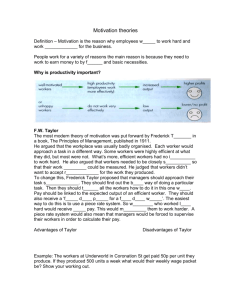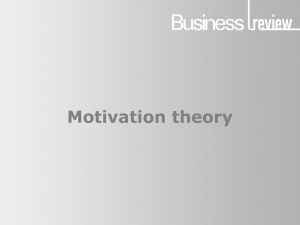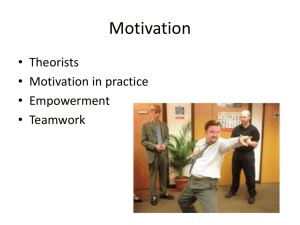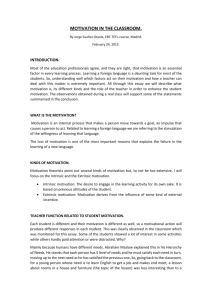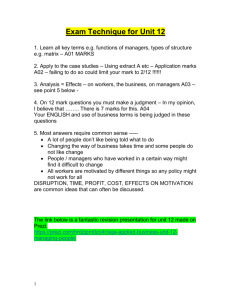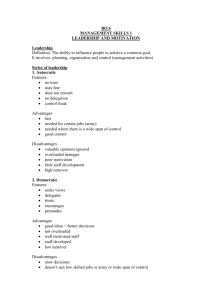Unit 2.5 Motivation Lesson 1
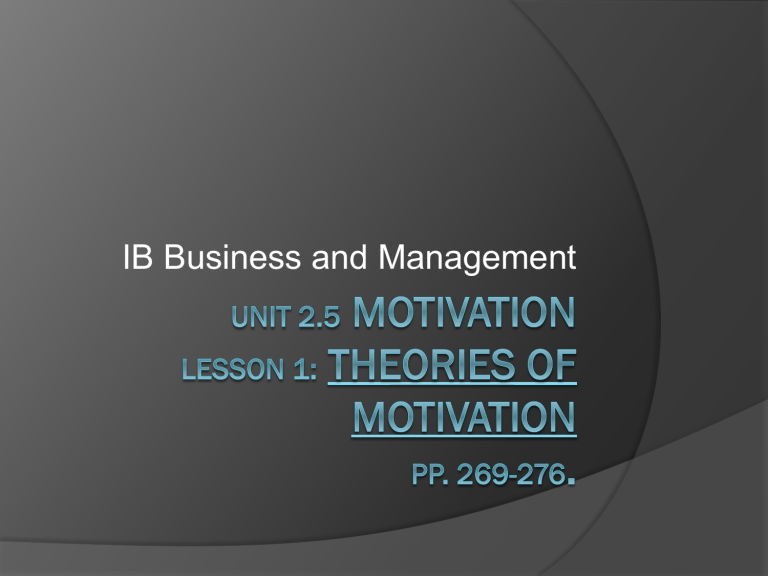
IB Business and Management
1. Think about it…
President Jefferson
(1743-1826) once said,
“ I’m a great believer in luck, and I find the harder I work, the more luck I have .”
What did he mean by this?
What motivates you to do something?
Are you easily motivated?
…
2. Focus Questions
What are the several theories of motivation?
What are the differences between intrinsic and extrinsic needs and rewards ?
What are the benefits of increased worker motivation?
Are there any negative aspects to poor worker motivation ?
…
3a. Motivation
Motivation
:
General: Desire, effort, and passion to achieve something
Business: Willingness to complete a task with enthusiasm
Getting someone to do what you want OR wanting to do something for yourself
3a. Motivation
Managers /
leaders
main goal: inspire and
motivate
your workforce to complete tasks that are set out by you.
Think about how you are going to promote / instill in your staff the desire, effort, and passion to complete a task with enthusiasm.
Must determine what drives your employees.
3a. Motivation
Remember:
People are the most valuable and expensive asset of any company.
It only makes senses to get the most out of your human resources, doesn’t it?
Focus of 2.5
: How managers seek to motivate their workforce to maximize job satisfaction, moral, and labor productivity
What are some of the benefits of a motivated workforce ? ...
Higher morale and job satisfaction
$$$
Higher profits
$$$
Benefits of increased worker motivation
Lower absenteeism
Lower staff turnover
Improves corporate image
Lowers conflict in the workplace
Increased number of disciplinary problems
High absenteeism rates
Warning signs of poor motivation
Poor punctuality
High labor turnover rates
High waste level
Increased customer complaints
Low quality output
3d. Motivation
Can be classified as in trinsic or ex trinsic.
People can be motivated by combination of both factors.
Intrinsic motivation:
When you engage in an activity out of your own desire.
○ Because you find them challenging, stimulating, or satisfying.
Extrinsic motivation:
When you participate in an activity because of the benefits and rewards associated with the activity.
○ The rewards maybe:
Tangible : wages, salaries, bonuses, YOUR grade
Intangible : recognition or praise, to avoid punishment, candy, prizes
…
4. Motivation in Theory
YOU
as a manager in a company will need some knowledge and understanding of how your employees or staff think and what motivates them and even finding out what really motivates you.
Because at the end of the day, or at the beginning, even you have a boss or someone to answer to and they will have to motivate you !
4b. Frederick Winslow Taylor (1856-1915)
Supported the use of piece-rate payment system .
Wrote a book on “The Principles of
Scientific Management (1911).
He assumed that people were motivated by money.
He also believed that higher productivity could be obtained by setting output and efficiency targets related to pay.
He viewed the duty of the manager to decided how each person’s task should be completed.
Supported repetitive tasks based on division of labour and specialization in the production process.
He suggested that man try to do as little as possible.
That managers need to plan, direct and control their workforce. …
4c. Frederick Winslow Taylor (1856-1915)
He also introduced differentiated piecework .
A payment system where a work would receive pay based on a standard level of output and receive another rate if they exceeded that level.
This was his incentive scheme that reward those who were productive workers.
He recommended that workers should be scientifically selected for jobs, based on their abilities.
His ideas were very popular in 1920’s,
Ford and McDonald’s would use them. McDonald's still uses them today. …
4d. Frederick Winslow Taylor (1856-1915)
He has been criticized for ignoring the non-physical contributions of workers.
That can be defined: labour input as the mental and physical human effort used in the production process.
So how easy is it to measure this?
○ It is not easy at all to measure the “output” of certain professionals.
For example, if you all get accepted into an Ivy League school, does that make me a great teacher, a productive employee of the school?
…
4e. Frederick Winslow Taylor (1856-1915)
He has also ignored the non-financial factors.
Due to a highly educated workforce, people do not prefer to be bossed around, but would like a say in how things are done at work.
His theory can also lead to repetitive and monotonous tasks.
This will lead to job dissatisfaction rather than motivation.
Can you think of some other companies or countries who might use Taylor's theories ?
Do you think his theories are still being practiced today? Can you give examples?
..
5a. Abraham Maslow (1908-1970)
Maslow’s Hierarchy of Needs
Focused on the psychological
(emotional and mental) needs of workers.
He believed people are motivated by more than just money.
He argued that these needs (see right pyramid) must be met to motivate people.
Called the Hierarchy of needs (1943).
…
5b. Abraham Maslow (1908-1970)
Maslow’s Hierarchy of Needs
He also suggested that the needs at the lower level must be met before people could progress to higher level needs.
Let’s think about it…would it be feasible for a company to aim to motivate all workers up the hierarchy ?
Which workers would you want to motivate the most? And at which levels in the hierarchy?
…
5c. Abraham Maslow (1908-1970)
Maslow’s Hierarchy of Needs
Some criticize Maslow on how difficult it is to measure the level of needs.
How can a business measure esteem or love issues of an employee?
He also assumed that everyone is motivated in the same pre-determined order of his model.
And what motivated the people who have achieved selfactualization ?
What drives Bill Gates or Donald
Trump?
…
What motivates these kinds of people to keep on working?
6a. Douglas McGregor
Created the Theory X and
Theory Y (1960) to represent the different assumptions managers have about their employees.
His theory was that the beliefs managers have about worker attitudes directly influences their management style.
Confused?
McGregor’s theory focuses on manager’s attitudes, not on a motivational theory.
…
6b. Douglas McGregor
Theory X explains the negative management attitude about the workforce .
Workers as lazy, avoiding work.
Workers need to be given direction and clear instructions.
Authoritarian management style.
Emphasis is on output and productivity.
You will follow Taylor’s scientific management approach.
…
6c. Douglas McGregor
Theory Y managers take a more positive approach.
Assume employees are able to achieve objectives on their own.
Think workers can gain satisfaction from work and are able to take on responsibility.
McGregor suggested that workers will be less motivated if there is a lack of challenge in a job.
Theory Y managers take a democratic and decentralized approach in their style .
So, adopt the Theory Y approach!!!
…
“Never tell people how to do things.
Tell them what to do and they will surprise you with their ingenuity.”
US Army General George S. Patton (1885-1945)
7a. Prof. Frederick Herzberg (1923-2000)
Focuses on what causes satisfaction and dissatisfaction at work.
These fall under his
Hygiene factors
(maintenance factors)
○ These meet people’s basic needs.
○ Must be met to prevent dissatisfaction
A pay raise will not motivate an employee in the long run.
…
7b. Prof. Frederick Herzberg (1923-2000)
Motivators :
Factors which lead to the psychological growth of the employee.
Will increase worker satisfaction and performance.
Suggested that firms motivate employees by using a democratic management style, provide training,
Three Key areas in worker motivation :
1.
Job enlargement : variety in what workers do.
2.
3.
Job enrichment : more complex and challenging tasks.
Job empowerment : delegating decision-making power to workers.
…
7c. Prof. Frederick Herzberg (1923-2000)
Movement and Motivation:
Movement : when someone does something because they need to. (extrinsic)
Motivation : when someone does something because they want to. (intrinsic)
He believed that people are motivated by being responsible for their work.
…
That work itself can be rewarding.
7d. Prof. Frederick Herzberg (1923-2000)
So as a manager you need to make sure your employees are motivated.
But remember, not all employees are motivated the same way.
What works to motivate them today, may not work tomorrow.
Critics of Herzberg :
His two factor theory does not apply to many occupations.
Especially where job enrichment and job empowerment are not a feature. i.e. at a factory.
Also, some employees do not want job enrichment, they do not want the extra responsibility.
His research also ignored the role of the team working in motivating the workforce.
…
IB Business and Management
1. Focus Questions
What are the differences between financial and non-financial motivation?
2. An overview:
Financial motivation
:
A way for companies to motivate workers by using some form of monetary rewards.
Non-financial motivation
:
Non-monetary factors that motivate people by offering psychological and intangible benefits.
…
Fringe payments.
Perks.
Wages.
Time-based payment systems.
Overtime.
Piece rate.
(remember
Taylor?)
Employee share ownership schemes
Financial Motivation
(look at the advantages and disadvantages of each on pp.281-285)
Salary
Performancerelated pay
(PRP)
Profit-related pay.
Profit sharing.
Commission
(output-based payment system)
Job enrichment
Worker participatoion
Delegation
Continuous professional development
(Herzberg)
Vertical loading= challenging jobs
Job enlargement
Increase number of tasks
Job rotation
(horizontal loading)
Non-financial
Motivation
Doing a number of tasks in order
( look at the advantages and disadvantages of each
Empowerment on pp.286-290 ) Granting more authority to the
Team working workers
The working environment
Recognition and praise
Working in groups reduces boredom.
(Adair &
Belbin model)
5a. Team Building Models
The Adair Model :
Three parts to effective team work.
1.
Tasks must be challenging.
2.
3.
Team must work collectively.
Team caters for the needs of each member.
An idea situation where team leaders strive to accomplish challenging tasks, build teams and develop individuals.
You as the manager or team leader will be dealing with group dynamics .
The range of individual problem-solving skills and experience.
You will need to reinforce the importance of every member on your team.
…
Team
Task
Individual
5b. Team Building Models
The Belbin Model :
Looks at the behavior of managers from all over the world.
They were put in groups and psychometric test were conducted.
The finds were as follows:
○ Nine patterns of behavior or team role: ( see more info on pp.288-289 )
Action Orientated
• Shaper
• Implementer
• Completer Finisher
People Orientated
• Coordinator
• Team worker
• Resource
Investigator
Cerebral Orientated
• Plant
• Monitor Evaluator
• Specialist
